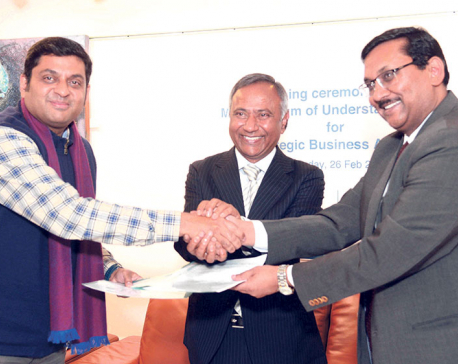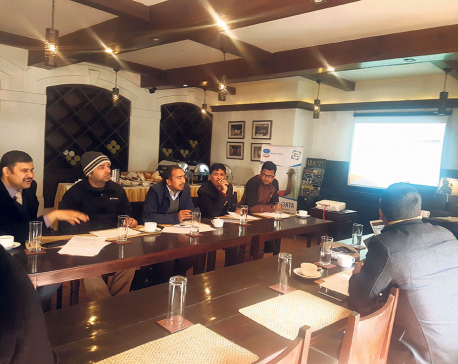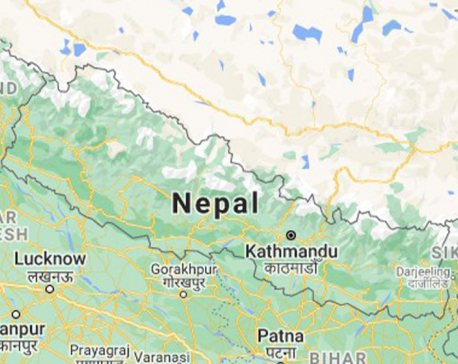
OR
Bank on data
Published On: October 3, 2018 01:30 AM NPT By: Deepak Singhania and Thomas van den Aarssen


Deepak Singhania and Thomas van den Aarssen
Deepak Singhania is a Research Fellow and Thomas van den Aarssen a Senior Research Manager at EPoD India at IFMR, a joint program by Evidence for Policy Design at Harvard Kennedy School and the Institute for Financial Management and Researchnews@myrepublica.com
More from Author
Nepal is standing at a critical juncture of political and economic change that presents new opportunities to collect, open, and act on data
Data can help enhance government services to citizens and improve lives. Nepal is standing at a critical juncture of political and economic change that presents new opportunities to collect, open, and act on data.
One need not go too far in the back to see how data has played a crucial role during one of the biggest crises in Nepal. The response to the devastating earthquake in 2015, when data was crucial in tackling the widespread damage, is illustrative. A team of Nepali data analysts led by Nama Budhathoki, the founder of Kathmandu Living Labs (KLL), collaborated with seven government agencies, hired 2,500 engineers and managed to collect six terabytes of data in three months from the 11 most affected districts. For this, they had decided to steer away from the traditional pen-and-paper method of surveying to using digital technology. Indeed, in a usual course of affairs there would be a trade-off between generating quick data and quality data.
This data was crucial in informing the relief response by the government and other supporting institutions. Later, Housing Recovery and Reconstruction Platform (HRRP), along with CBS and National Reconstruction Authority (NRA), conducted surveys in 31 districts in less than a year. In 11 districts and rural areas of a 12th district, the survey actually censused every inhabitant. These datasets informed the post-earthquake reconstruction and recovery support to the affected households, whose progress is being diligently, tracked via data dashboards on the HRRP website.
This was a response to the need of the hour in a time of crisis, but it doesn’t stop the country from emulating this kind of data collection to help with less visible crises of poverty, hunger, unemployment and marginalization.
Nepal in data
In a recent data deep-dive exercise, we at Evidence for Policy Design (EPoD) examined the data available to guide policy decisions in Nepal. We learned that even though there are some datasets that can provide insights on the socio-economic landscape of Nepal, more needs to be done to improve data availability and representativeness—to the extent to which data on the few can guide policy for the many. Currently there isn’t enough data, or enough user-friendly data, to facilitate generation of actionable evidence for the government to design well-informed policies and for development actors to analyze policies. According to Open Data Barometer (ODB), which covers 115 countries and 15 kinds of data, Nepal ranks 83rd in the government’s use and publishing of open data for accountability, innovation and social impact.
The online catalog of Nepal’s Central Bureau of Statistics (CBS) includes 55 datasets over a period of about 50 years. Of these, 38 percent are available by request and the remaining are unavailable for public use. By comparison, Indonesia, a country that underwent a transition from long-ruling monarchy to decentralized state similar to Nepal’s, has a total of 311 datasets in its online central data catalogue. Of these 94 percent are available by request and only six percent are unavailable for public use.
The stock of data in Nepal is relatively low. So is the frequency at which some of the key developmental datasets are collected.
For example, labor is one of the most important components of a country’s wealth, and the quality of the labor supply—meaning the characteristics of who is working and how—dictates a country’s growth. But stock-taking of the labor force in Nepal is infrequent. There is a 10-year interval between Nepal’s labor force surveys. In contrast, the interval is under three years in Bangladesh, China, India and Pakistan.
It is well known that a large part of the Nepali labor force is working outside the country. Even in this case, the data on migrants is available only for those who migrate through labor permits, while a large proportion of migrants go to India where labor permits are not required. As a result, there is no real data on Nepal-India migration aside from rough estimates. Research and policy analysis are then overly focused on migrants with labor permits, who primarily work in countries other than India.
By contrast, Mexico, a country with both documented and undocumented migration, has invested heavily in generating data on migration. The Mexican Migration Project has been collecting yearly data on households and individuals since 1987, and the Mexican Family Life Survey has collected data on migration and socio-economic characteristics for the same set of households every four years since 2002.
A recent report finds that Nepal has significant data gaps to monitor and track progress on the Sustainable Development Goals, and that there is a shortage of data in the fine-grained form that is most useful.
What Nepal can do
How can data help with such complex problems? First, it should start by systematic generation of administrative datasets created in the process of service delivery by different departments and tiers of government. These administrative datasets could be highly informative and can be used to inform policies to further improve service deliveries.
Second, public servants can collaborate with researchers, Nepali and non-Nepali, to identify key policy areas that are priority for Nepal’s development. This will help them identify the questions they want to answer and the kind of datasets that would be needed to answer those questions.
Finally, the government can promote a culture of evidence-informed policy by creating an environment where it’s easier for well-meaning organizations to be involved in data collection and producing policy relevant research. For this, it can start by opening up its administrative data and other data collected by public institutions like CBS for public use. Next, it can commission data collection with the help of local governments who can also receive support from non-government organizations. This collaborative culture of generating data and evidence is important because no organization or institution can or will have the capacity to single-handedly achieve this task.
One thing is certain. Nepal should not wait for the next crisis to realize the importance of data.
Deepak Singhania is a Research Fellow and Thomas van den Aarssen a Senior Research Manager at EPoD India at IFMR, a joint program by Evidence for Policy Design at Harvard Kennedy School and the Institute for Financial Management and Research
deepak.singhania@ifmr.ac.in
thomas.vandenaarssen@ifmr.ac.in
You May Like This

Standard Chartered Bank Nepal, Nepal Mediciti join hands
KATHMANDU, Mar 1: Standard Chartered Bank Nepal Ltd (SCBNL) and Nepal Mediciti have signed an agreement to provide various discounted... Read More...

Nepal in Data to launch smart data analysis
KATHMANDU, Feb 17: While the political and cultural history of a nation is written in words and phrases, the same for... Read More...

Is Landlockedness a Boon or a Curse for Nepal? Changing the Grand Narrative
Nepal’s landlockedness should be viewed from an agathokakological sense, not just as an ill-fate. Nepal can just give a damn... Read More...




Just In
- CM Kandel requests Finance Minister Pun to put Karnali province in priority in upcoming budget
- Australia reduces TR visa age limit and duration as it implements stricter regulations for foreign students
- Govt aims to surpass Rs 10 trillion GDP mark in next five years
- Govt appoints 77 Liaison Officers for mountain climbing management for spring season
- EC decides to permit public vehicles to operate freely on day of by-election
- Fugitive arrested after 26 years
- Indian Potash Ltd secures contract to bring 30,000 tons of urea within 107 days
- CAN adds four players to squad for T20 series against West Indies 'A'














Leave A Comment